Karen Lynn Allen's Blog, page 5
February 20, 2015
Universal Time Available for Pre-Order on Kindle

If you're a Kindle reader, Universal Time, is now available for pre-order. Release date is March 6th. Paperback edition should be out that date as well, and can be ordered then from any bookstore, all on-line booksellers, etc.
From the back cover:
@font-face { font-family: "Arial"; }@font-face { font-family: "MS 明朝"; }@font-face { font-family: "MS 明朝"; }@font-face { font-family: "Cambria"; }@font-face { font-family: "MinionPro-Regular"; }p.MsoNormal, li.MsoNormal, div.MsoNormal { margin: 0in 0in 0.0001pt; font-size: 12pt; font-family: Cambria; }p.NoParagraphStyle, li.NoParagraphStyle, div.NoParagraphStyle { margin: 0in 0in 0.0001pt; line-height: 120%; font-size: 12pt; font-family: MinionPro-Regular; color: black; }.MsoChpDefault { font-family: Cambria; }div.WordSection1 { page: WordSection1; }
Cait could’ve forgiven Atraxis for plucking her off the streets of San Francisco, but moving in upstairs was just too much. As a divorced mother, she had enough troubles with her children and her job creating affordable housing. She didn’t need aliens hounding her for the Tamaranth, the ancient crown of Trajallax. (Why, why had Jupeernis stolen the Tamaranth and hidden it in her jaw so that Atraxis had to hunt her down to retrieve it?)
Yes, Atraxis might be an intergalactic conflict mediator. Yes, he might come from an incredibly advanced society whose language was music; yes, he might travel across the universe in minutes and turn his skin blue at will. But none of this meant she had time to go gallivanting to other galaxies with him. Nor did she want to marry him and have his (blue) child.
And now her former sister-in-law was dating Atraxis’s former brother-in-law (this could get ugly), her daughter was having ADD problems at school, and her ex-husband was dropping his baby off for her to watch so that he could go antiquing with his new wife. Yes, the universe might be knocking at her door, but she had no time to answer.
Universal Time—a sci-fi urban comedy that will transport you across the universe and back again.
Published on February 20, 2015 08:31
February 13, 2015
Sneak Peak of New Novel
Sneak Peak of the cover for my new novel, Universal Time.
 A sci-fi urban comedy, out in early March!
A sci-fi urban comedy, out in early March!
 A sci-fi urban comedy, out in early March!
A sci-fi urban comedy, out in early March!
Published on February 13, 2015 19:45
September 7, 2014
Train Trip! Part 4
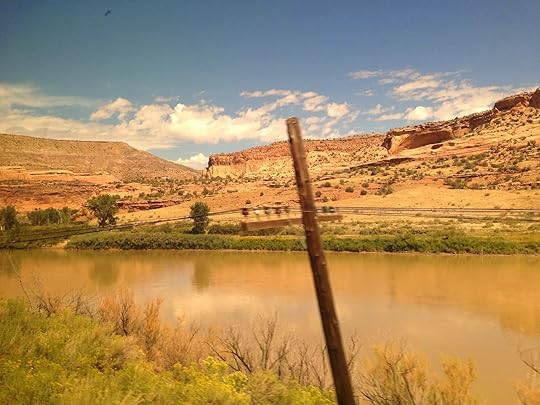 I’ve decided this train barely works for transportation but is fabulous for sightseeing. And I don’t think it can be fixed. The tracks follow the Colorado River too closely. To fashion a train that can go over 30 mph will necessitate a different route, probably one with more tunnels, one that doesn’t follow the river, one that can maintain some straight lines.
I’ve decided this train barely works for transportation but is fabulous for sightseeing. And I don’t think it can be fixed. The tracks follow the Colorado River too closely. To fashion a train that can go over 30 mph will necessitate a different route, probably one with more tunnels, one that doesn’t follow the river, one that can maintain some straight lines.The route of the California Zephyr from Salt Lake City to Denver is truly breathtakingly gorgeous. (And it wasn’t chopped liver in California or Nevada either.) I highly recommend it. I can’t imagine any cruise being any more beautiful. Just have no expectations of getting anywhere in any sort of time frame. I would guess in ten years there will be a high speed train from San Francisco to Chicago that will take 20 hours (12 from SF to Denver), but it won’t be nearly as pretty. I expect the California Zephyr, left to us by our nineteenth century forebears, will remain as a tourist sightseeing line, just as some scenic highways still existed after the interstate was put through.
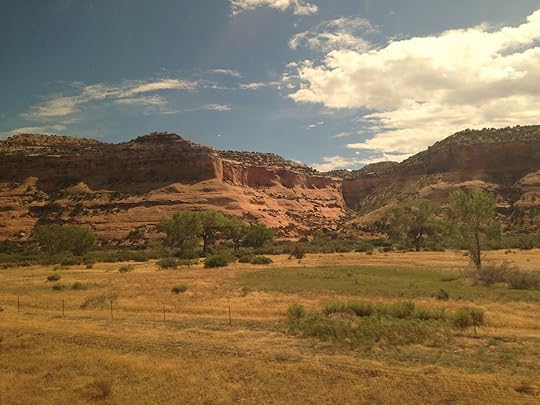 The assistant conductor noted the wildlife we might see from the train—heron, deer, egrets and black bears. Evidently they’ve seen black bears three times in the last month. I’ve seen heron, deer, Canada Geese and various river rafters performing the mooning ritual, but no bears. I’d like to see a bear again—it’s been a while. Viewing one from inside a train seems a nice vantage point.
The assistant conductor noted the wildlife we might see from the train—heron, deer, egrets and black bears. Evidently they’ve seen black bears three times in the last month. I’ve seen heron, deer, Canada Geese and various river rafters performing the mooning ritual, but no bears. I’d like to see a bear again—it’s been a while. Viewing one from inside a train seems a nice vantage point.If I were to do this trip again, I’d bring more food to eat. The food on the train is expensive, carbohydrate heavy, and not much better than adequate. (But unless I brought a cooler, 36 hours is hard to manage?) But the views, the views. I am told we are climbing up to a 9700 foot pass where, after a 6 mile pitch black tunnel, we can see a stunning drop down to a gorge below. I am hoping we get there when it is still light.
 We had to stop 15 minutes in the middle of nowhere and wait for another Amtrak train to pass. What’s up with that? We are now scheduled to arrive at 10pm, 3 and ½ hours late. I hope my friends in Denver are checking the train arrival status because at present I am out of service and can’t contact them.
We had to stop 15 minutes in the middle of nowhere and wait for another Amtrak train to pass. What’s up with that? We are now scheduled to arrive at 10pm, 3 and ½ hours late. I hope my friends in Denver are checking the train arrival status because at present I am out of service and can’t contact them.Of the 36 hours of this trip, an entire two have been motionless, devoted to smoke breaks that have not benefited me one whit. Worse, I can smell cigarette smoke right now on my car. (Someone is sneaking one somewhere.) What is it with smokers and trains?
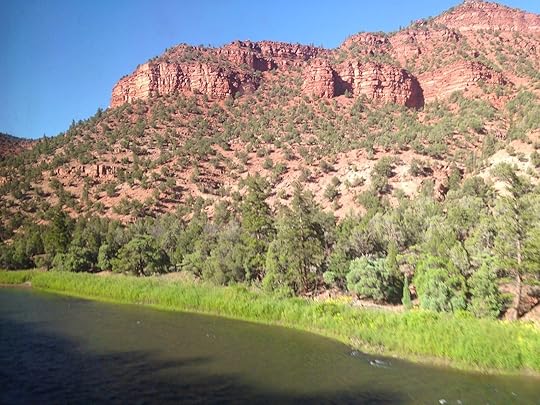 Daylight fades. The light and scenery are so beautiful out, this is a tragedy. I can’t believe there’s three more hours to Denver. On google maps we appear so close, it should be just a hop, skip and a jump. We drift along in the golden sunset at our luxurious crawl, and now we stop to let a freight train go by. (Seriously, the amount of stopping is ridiculous.)
Daylight fades. The light and scenery are so beautiful out, this is a tragedy. I can’t believe there’s three more hours to Denver. On google maps we appear so close, it should be just a hop, skip and a jump. We drift along in the golden sunset at our luxurious crawl, and now we stop to let a freight train go by. (Seriously, the amount of stopping is ridiculous.) Train travel has its own rhythm, its own life. Everyone on the train is part of a system, our fates intertwined for the duration of the journey. This era of American train travel known as Amtrak will eventually give way to something that works a whole lot better, but in the meantime, I recommend seeing America in this entirely unique, if at times frustrating, fashion. There is literally nothing like it. I’ve driven across the country multiple times. While driving has its moments of beauty and epiphany, this is like an extended meditation.
 Oh my goodness. Huge full moon has just popped up over the horizon. Maybe darkness will have its consolations.
Oh my goodness. Huge full moon has just popped up over the horizon. Maybe darkness will have its consolations.
Published on September 07, 2014 18:57
Train Trip! Part 3
 Gorgeous Utah (an iphone camera can't do justice)The train is now 3 hours and 26 minutes delayed. The electrical debacle of yesterday evening cost us 3 hrs or so, but we haven't made it up with shorter stops at the stations or faster speeds. Instead we've lost more time. Most of our journey is literally at speeds of 30 mph.
Gorgeous Utah (an iphone camera can't do justice)The train is now 3 hours and 26 minutes delayed. The electrical debacle of yesterday evening cost us 3 hrs or so, but we haven't made it up with shorter stops at the stations or faster speeds. Instead we've lost more time. Most of our journey is literally at speeds of 30 mph.Why am I in a hurry? After all, this is Amtrak. Many people are on vacation, choosing to take an Amtrak tour of the US instead of, say, a cruise to Alaska. They have all the time in the world. (They are also in private sleeper cars and eat every meal in the dining room.) The poor slobs in coach, well, you should have known what you were in for.
The thing is, rail can be electrified. Airplanes cannot. Cars can be electrified for short distances, but for long distances, they will be expensive energy gobblers, and it will be a long time before both our electrical grid and average household finances can support large numbers of them. In the medium term, electrified rail is what we're going to have. I know most people can't imagine this. This is why we, as a nation, won't deal with the reality that is pretty much baked into the cake (via climate change and peak oil) until it slaps us in the face.
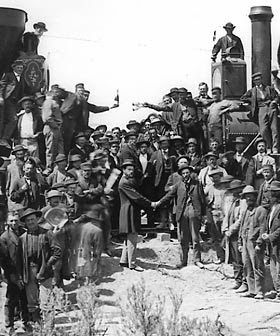 An achievement indeed in 1869Europe, China and Japan have invested in train infrastructure, and as a result their trains go four to eight (yes, eight!) times faster than ours. It is possible to have trains that substitute for plane trips under a 1000 miles rather well, but with the exception of the northeast corridor from Boston to Washington DC, our trains poke along like the Civil War just ended and Ulysses S. Grant is on board smoking his cigar. Hey, I have nothing against nostalgia and I love Ulysses S. Grant. The problem is, nostalgia doesn't create viable transportation, and we will soon be wishing our train lines weren't quite such a relic of another age. Train travel at 100 mph would be a piece of cake if we weren't so placidly accepting of rail infrastructure that hasn't been updated since Eisenhower got the grand idea to create the interstate highway system.
An achievement indeed in 1869Europe, China and Japan have invested in train infrastructure, and as a result their trains go four to eight (yes, eight!) times faster than ours. It is possible to have trains that substitute for plane trips under a 1000 miles rather well, but with the exception of the northeast corridor from Boston to Washington DC, our trains poke along like the Civil War just ended and Ulysses S. Grant is on board smoking his cigar. Hey, I have nothing against nostalgia and I love Ulysses S. Grant. The problem is, nostalgia doesn't create viable transportation, and we will soon be wishing our train lines weren't quite such a relic of another age. Train travel at 100 mph would be a piece of cake if we weren't so placidly accepting of rail infrastructure that hasn't been updated since Eisenhower got the grand idea to create the interstate highway system. More gorgeous sceneryThe good news is that the scenery in Utah is phenomenal. Magnificent. Stunning. Didn't see much of Salt Lake City because it was still dark when we got there, but ever since the wide-sweeping views drenched in clear, golden sunlight have been glorious. And there's plenty of time to soak it in as we coast by at 30 mph. (Okay, we may be at 40mph right now.)
More gorgeous sceneryThe good news is that the scenery in Utah is phenomenal. Magnificent. Stunning. Didn't see much of Salt Lake City because it was still dark when we got there, but ever since the wide-sweeping views drenched in clear, golden sunlight have been glorious. And there's plenty of time to soak it in as we coast by at 30 mph. (Okay, we may be at 40mph right now.)Sleeping in coach was by no means comfortable but slightly better than I'd anticipated. I brought a neck pillow. (Good.) I wish I'd brought a lightweight, easy-to-pack blanket. Pretty much everyone had two seats to sleep on, and it was interesting to observe different people's reclining strategies. For me it was one of those sleep for an hour, wake briefly to reposition, go back to sleep for an hour nights. Got six hours of sleep. Could've been worse. When I woke for good, it was still dark and there was a huge orangey full moon in the sky ready to set.
 Place to take the kids
Place to take the kids The young couple with the little kids got off in Salt Lake City. Though the kids slept well all night, I fear the earlier delay tried the patience of their parents beyond their reserves. Per hour spent, traveling with children on a train is easier than on an airplane (room to move, room for them to lie down and take a nap, stuff for them to see out the window, able to walk them around, go hang out in the lounge car) but having to get through so many more hours is challenging. Little kids are cute, little kids are wonderful, little kids are so much work! I have to say I'm glad I'm through with that part of my life.
Okay, I should give Amtrak its due. We've made up half an hour and now are only 2 hours and 50 behind schedule. And we may actually be going 45 mph at the moment. We're still on the flats of Utah. The long climb into the Rockies is ahead.
Published on September 07, 2014 10:54
September 6, 2014
Train Trip! Part 2
 Oak trees of the foothills gradually give way to pines of the Sierras that give way themselves to the high desert of Nevada. The seniors behind me left and were replaced by a twenty-something couple. Kids ahead took a couple hour nap. They are getting off in Salt Lake City at 3 in the morning. I'm guessing I'll notice them go. The baby (maybe 4 four months old?) has blond hair that sticks straight up and a fabulous baby grin.
Oak trees of the foothills gradually give way to pines of the Sierras that give way themselves to the high desert of Nevada. The seniors behind me left and were replaced by a twenty-something couple. Kids ahead took a couple hour nap. They are getting off in Salt Lake City at 3 in the morning. I'm guessing I'll notice them go. The baby (maybe 4 four months old?) has blond hair that sticks straight up and a fabulous baby grin.The train filled up quite a bit before Reno but is now emptier again. I have my two seats steadily to myself and have been able to get some writing done. At Reno the conductor announced a "fresh air" break. What this meant was it was time for everyone to rush outside and smoke a cigarette. So much for fresh air, but I imagine if you're hooked on cigarettes a long ride on a non-smoking train is rough.
 We crawled up the mountain to Truckee at 25--30 mph tops. And now that we're in the flats of Nevada we're going maybe 55 or 60 mph. Part of the reason we went so slowly through the mountains is that there were lots of curves. Basically the rail infrastructure in the Sierras is not all that different from what was built by Chinese laborers with pick axes and a little dynamite a hundred and fifty years ago. The entire 1,907 miles of the Transcontinental Railroad was built in six years. (Six years! With no power equipment!) In the last sixty years as a country we've spent trillions building flat, straight highways with bridges and other structures galore to smooth things out. The same is not true for our railroads. They still have the curves. In 1950 it took 49 hours to get from San Francisco to Chicago on this line. Now it takes 50. We have made no progress at all.
We crawled up the mountain to Truckee at 25--30 mph tops. And now that we're in the flats of Nevada we're going maybe 55 or 60 mph. Part of the reason we went so slowly through the mountains is that there were lots of curves. Basically the rail infrastructure in the Sierras is not all that different from what was built by Chinese laborers with pick axes and a little dynamite a hundred and fifty years ago. The entire 1,907 miles of the Transcontinental Railroad was built in six years. (Six years! With no power equipment!) In the last sixty years as a country we've spent trillions building flat, straight highways with bridges and other structures galore to smooth things out. The same is not true for our railroads. They still have the curves. In 1950 it took 49 hours to get from San Francisco to Chicago on this line. Now it takes 50. We have made no progress at all.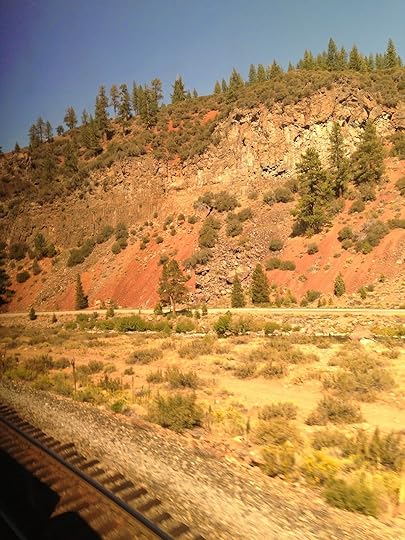 Made a reservation to eat in the restaurant at 5:30. There are two sittings, one at 5:30 and one at 7:15. Am hoping food is edible.
Made a reservation to eat in the restaurant at 5:30. There are two sittings, one at 5:30 and one at 7:15. Am hoping food is edible.Our train has stopped absolutely in the middle of the desert because we've somehow picked up debris between our wheels and they need to clean it out. Or examine it. Or something. At least they gave us an explanation. However, the train is dead still and all power is off, which means all air conditioning is off. Oy, oy. This is the kind of delay that makes trains late.
It is very quiet. There may be few things quieter than a dead train in the middle of the Nevada desert.
So it is not debris. Some kind of power cable blew out in the baggage car (perhaps due to debris?) and that's why the power is completely off in the rest of the train. They have to take the locomotives and baggage car off the train and do various adjustments (put the baggage car last?) and then we will have power. Dinner is delayed until the power is returned. We are in the middle of nowhere--not like there's a place to get spare parts. But they say they can fix it. It is 5:30 and still light which is fortunate. This place seriously looks like one of those old western movies where bandits make the train stop in the middle of nowhere so they can then sweep down on the train and rob it.
 Waiting for cowboysNow Union Pacific wants us off to some siding so that they can get through. (We've created a rail traffic jam!) We are coasting without electrical power due to the electrical cables being kaput. Getting warm in the car. A little tiny voice comes out of the PA system since there is no power to amplify it. I look out my window and expect to see cowboys and Indians any minute. Adventure, although perhaps not exactly the kind I wanted. We will see if the power comes back on before the batteries on my gadgets run out. I might actually have to crack a book. I suppose if things get really bad we can get off and walk.
Waiting for cowboysNow Union Pacific wants us off to some siding so that they can get through. (We've created a rail traffic jam!) We are coasting without electrical power due to the electrical cables being kaput. Getting warm in the car. A little tiny voice comes out of the PA system since there is no power to amplify it. I look out my window and expect to see cowboys and Indians any minute. Adventure, although perhaps not exactly the kind I wanted. We will see if the power comes back on before the batteries on my gadgets run out. I might actually have to crack a book. I suppose if things get really bad we can get off and walk.
Published on September 06, 2014 17:37
Train Trip Live Blogging! Part I
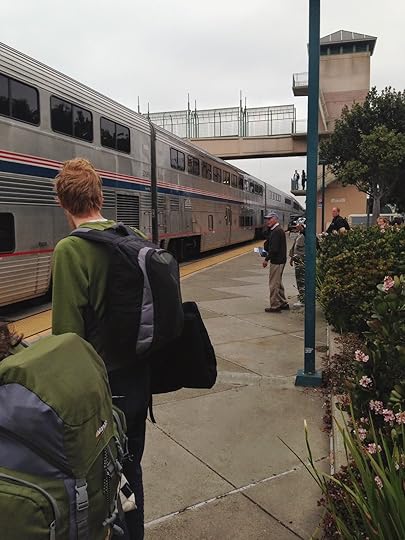 My Train!I am taking the California Zephyr (nice name) to Denver. It will take about 34 hours. While I've taken a number of long-distance overnight trains in Europe (and even Russia) this is my first in the US. I actually want to go to Cedar Rapids, Iowa, but while this train passes through Iowa, it would take me six hours via transit to go the hundred miles from the closest Amtrak station to Cedar Rapids, and I just didn't think I could bear it. It would also take another 14 hours to go from Denver to Mt. Pleasant, IA, and would require another night sleeping somewhat upright on the train. (Losing one night of sleep I could face. Two is a little more daunting.) But this has the fortunate result that I can visit friends in Denver I haven't seen in a while and then fly from Denver to CR.
My Train!I am taking the California Zephyr (nice name) to Denver. It will take about 34 hours. While I've taken a number of long-distance overnight trains in Europe (and even Russia) this is my first in the US. I actually want to go to Cedar Rapids, Iowa, but while this train passes through Iowa, it would take me six hours via transit to go the hundred miles from the closest Amtrak station to Cedar Rapids, and I just didn't think I could bear it. It would also take another 14 hours to go from Denver to Mt. Pleasant, IA, and would require another night sleeping somewhat upright on the train. (Losing one night of sleep I could face. Two is a little more daunting.) But this has the fortunate result that I can visit friends in Denver I haven't seen in a while and then fly from Denver to CR.My journey starts at 6:55 when I leave my house to walk to the bus stop. I take a Muni bus to the Castro and Market station, then take Muni light rail to the Embarcadero Station. Walked to the Amtrak waiting/bus boarding area just to the south of the Ferry Building. Got there early. (Little traffic early Saturday morning.) The Amtrak indoor waiting area is a bit grungy but there's no reason to go in if you already have a ticket. Am told I can take the 7:30 bus if I want instead of the 7:50. But for some reason things are chaotic. Everyone wants on board the 7:30 bus. Rumors of the 7:50 bus not working. And as I sit in my seat waiting for the bus to depart, the driver has a discussion with an attendant helping passengers board. He asks questions like, "Where's the brake?" and "How do you close the door?" This does not inspire confidence, but he manages to get us on the freeway, across the Bay Bridge and to Emeryville without mishap.
 Emeryville StationThe Emeryville station is nice and fairly clean. There's even a cafe/snack shop that sells Peets Coffee/Tea. Quite a few people in the waiting area. Turns out most of them are waiting for my train. Lots of retired folks. A few young adventurous types.
Emeryville StationThe Emeryville station is nice and fairly clean. There's even a cafe/snack shop that sells Peets Coffee/Tea. Quite a few people in the waiting area. Turns out most of them are waiting for my train. Lots of retired folks. A few young adventurous types.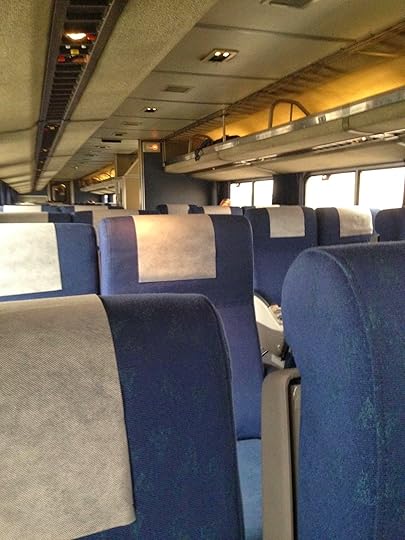 My carTrain is very long (!) and two levels tall. At 8:45, It pulls up well past the station. Sleeping cars in the rear. (Not me--quadruple the price. I am far too cheap.) Am directed to the Denver car. (Didn't know that everyone going to a given destination is grouped on the same car.) I keep walking and get on a car that has about six other people. (Can probably hold close to 50 upstairs alone.) Will be lovely if it stays this empty, or if at least the seat next to me stays empty. I haul my bag up a very narrow set of stairs to the second level. Have a nice big window, great view. My bag, which fits in airline overhead storage bins, does not fit in the Amtrak overhead storage bin and so it is at my feet. Luckily there is generous room between seats on this Superliner train--perhaps triple what you get on a standard airline economy seat. I half expect the conductor to yell at me about my bag, but none of them do. The conductors are very pleasant, but I overhear that they are concerned about the guy sitting two rows up from me who seems not entirely with it. (Drug-addled? Cognitive issues?) I agree with their assessment and am hoping he's harmless. The train pulls away precisely on time at 9:10.
My carTrain is very long (!) and two levels tall. At 8:45, It pulls up well past the station. Sleeping cars in the rear. (Not me--quadruple the price. I am far too cheap.) Am directed to the Denver car. (Didn't know that everyone going to a given destination is grouped on the same car.) I keep walking and get on a car that has about six other people. (Can probably hold close to 50 upstairs alone.) Will be lovely if it stays this empty, or if at least the seat next to me stays empty. I haul my bag up a very narrow set of stairs to the second level. Have a nice big window, great view. My bag, which fits in airline overhead storage bins, does not fit in the Amtrak overhead storage bin and so it is at my feet. Luckily there is generous room between seats on this Superliner train--perhaps triple what you get on a standard airline economy seat. I half expect the conductor to yell at me about my bag, but none of them do. The conductors are very pleasant, but I overhear that they are concerned about the guy sitting two rows up from me who seems not entirely with it. (Drug-addled? Cognitive issues?) I agree with their assessment and am hoping he's harmless. The train pulls away precisely on time at 9:10. View north
View northWe are stopped at Martinez. Out the window I see lots of people getting on, although none seem to be boarding this car. I am paying $124 for this ride to Denver, which is roughly comparable to what airfare would cost, although you have to consider paying for 36 hours of meals as well. I have packed my first lunch, but there will still be a dinner, breakfast and another lunch to get. I am hoping the train won't be dreadfully late getting to Denver so I don't required another dinner as well.
 California deltaI have chosen a seat on the right hand side. Since we're going east, this means my view is mostly southerly, (although I can also see across the aisle) and since we're passing through the California delta, it's mostly of fields. It's different than the freeway where the predominant views are of asphalt and other cars. Being up so high offers a nice sweeping view of terrain. Seems like the train horn blasts often. Car is air conditioned. The train lolls around on the track sometimes, and there are more vibrations than on an airplane. In general the roominess means it's more pleasant than driving or flying, the only downside is how slow it is! If in the US we had train speeds equal to slow European trains (not even the fast ones!) this train would zip along at 110-120mph, and I could get from the Bay Area to Denver in 12 hours. 12 hours is way better than 36. 12 hours means not having to sleep upright all night.
California deltaI have chosen a seat on the right hand side. Since we're going east, this means my view is mostly southerly, (although I can also see across the aisle) and since we're passing through the California delta, it's mostly of fields. It's different than the freeway where the predominant views are of asphalt and other cars. Being up so high offers a nice sweeping view of terrain. Seems like the train horn blasts often. Car is air conditioned. The train lolls around on the track sometimes, and there are more vibrations than on an airplane. In general the roominess means it's more pleasant than driving or flying, the only downside is how slow it is! If in the US we had train speeds equal to slow European trains (not even the fast ones!) this train would zip along at 110-120mph, and I could get from the Bay Area to Denver in 12 hours. 12 hours is way better than 36. 12 hours means not having to sleep upright all night. What I see at DavisBut that's still in the future. There is an electrical outlet next to my seat. My husband has given me a gadget that gives me access to wi-fi. I have hopes of getting some writing done, but I find I'm quite interested in the views. People walk by, on their way to the snack car behind this car, I think. Arriving Davis. This trip has a utilitarian function as transportation, but it is also for research for my next book. I have 36 hours to absorb the sights, sounds, rhythms, and light of train travel across America.
What I see at DavisBut that's still in the future. There is an electrical outlet next to my seat. My husband has given me a gadget that gives me access to wi-fi. I have hopes of getting some writing done, but I find I'm quite interested in the views. People walk by, on their way to the snack car behind this car, I think. Arriving Davis. This trip has a utilitarian function as transportation, but it is also for research for my next book. I have 36 hours to absorb the sights, sounds, rhythms, and light of train travel across America.At Sacramento. Quite a few people getting on car. Most everyone is over 65 or under 30. Quite the bimodal distribution. A couple who must be close to 80 sit down behind me. Another couple bearing many tatoos and two small children sit down in front of me. I feel old and young at the same time.
Woman across from me is traveling with a full size bed pillow. (I suspect she's done this before.) Baby in front irritable. Senior citizens behind jerking my seat to lower their footrest.
On our journey now for two hours, we pull away from Sacramento on time at 11:09. Many hopes this will keep up.
Published on September 06, 2014 11:11
May 14, 2014
The Great Transition (Welcome to the Decade of Substitutions)
 Sign of the times.
Sign of the times. We live in an age of great transition. We are in the midst of the monumental process of switching from one set of primary energy sources —fossil fuels— to another— renewables. During this transition we will see almost every facet of our lives altered as all sorts of substitutions are made in a far-reaching kaleidoscope of change. In fact, this metamorphosis is already happening in slow motion all around us. If you were to pull a Rip Van Winkle and sleep through the next ten years, you would wake up to a different world indeed.
 Promises, promises.We know from basic economics and pure common sense that substitutions will occur, because as the easiest-to-reach deposits of fossil fuels are burned up, the ones left take more energy and money to get out of the ground. (It turns out deep water and fracked oil are so expensive that the major oil companies haven't been making money on them the past few years, and they are getting mighty concerned about this. For more, see note at end.) This means prices of fossil fuels will inevitably rise so that more expensive oil/natural gas/coal can be produced. Or it means that demand will drop, keeping prices relatively steady. There's also the phenomenon of ever more humans arriving on the planet each day wanting to use energy, creating upward pressure on prices. This has been somewhat countered by economic contractions that drop demand by rendering consumers poorer. Besides suppressing demand, rising prices make other options more attractive. Hence, substitutions. Such substitutions are already gathering momentum, especially as more people realize that the price we pay for fossil fuels doesn't cover the costs of the environmental, health and climate damage they inflict. (Taxpayers and our children will pay those costs! Another rule of basic economics--make someone else pay the piper if you can.)
Promises, promises.We know from basic economics and pure common sense that substitutions will occur, because as the easiest-to-reach deposits of fossil fuels are burned up, the ones left take more energy and money to get out of the ground. (It turns out deep water and fracked oil are so expensive that the major oil companies haven't been making money on them the past few years, and they are getting mighty concerned about this. For more, see note at end.) This means prices of fossil fuels will inevitably rise so that more expensive oil/natural gas/coal can be produced. Or it means that demand will drop, keeping prices relatively steady. There's also the phenomenon of ever more humans arriving on the planet each day wanting to use energy, creating upward pressure on prices. This has been somewhat countered by economic contractions that drop demand by rendering consumers poorer. Besides suppressing demand, rising prices make other options more attractive. Hence, substitutions. Such substitutions are already gathering momentum, especially as more people realize that the price we pay for fossil fuels doesn't cover the costs of the environmental, health and climate damage they inflict. (Taxpayers and our children will pay those costs! Another rule of basic economics--make someone else pay the piper if you can.)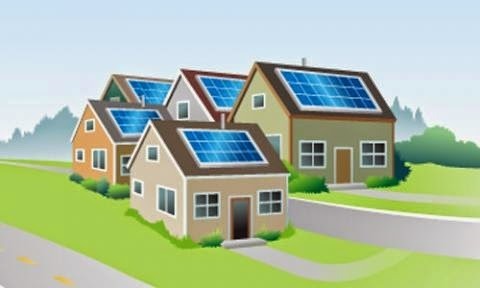 But where do the reindeer land?Of course not all fossil fuel use will need substitution, especially the not the fossil fuels we waste. Below I've outlined the substitutions of technology, infrastructure and behavior that we will likely see implemented around us over the next decade. Many of these technologies you will likely have in or on your house before 2020. Some of the substitutions involve lifestyle changes that almost all Americans will adopt before 2024. Successful regions will alter their infrastructure; those that don't will get left behind. My predictions may not be 100% accurate—there may be a few behaviors/infrastructures/technologies I’ve overlooked, or some surprising ones may spring up—but by and large this is what we have available to us right now and can expect to see.
But where do the reindeer land?Of course not all fossil fuel use will need substitution, especially the not the fossil fuels we waste. Below I've outlined the substitutions of technology, infrastructure and behavior that we will likely see implemented around us over the next decade. Many of these technologies you will likely have in or on your house before 2020. Some of the substitutions involve lifestyle changes that almost all Americans will adopt before 2024. Successful regions will alter their infrastructure; those that don't will get left behind. My predictions may not be 100% accurate—there may be a few behaviors/infrastructures/technologies I’ve overlooked, or some surprising ones may spring up—but by and large this is what we have available to us right now and can expect to see.Let’s take natural gas first.
Natural gas to heat indoor space will be replaced by heat pumps powered by electricity, passive solar gain where possible, and scattered high efficiency wood stoves.
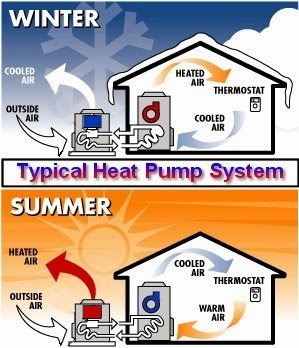 How to electrify heat.Heat pump technology is already mature. The only time heat pumps have issues is in climates that have deeply cold weather, and even then a properly sized heat pump can still heat your house, just less efficiently during the coldest days. (It also helps to have your house well-sealed and insulated so it doesn’t take much energy to heat it in the first place.) The added benefit to heat pumps is that they also cool much more efficiently than air conditioners, reducing electricity consumption in the summer. For those who live close to a large supply of wood, high efficiency wood stoves will be valuable—they use half the wood of older models to provide the same amount of heat and produce 1/10 to 1/20 of the particulate matter. (Important to asthmatics and other people who value their lungs!) This means less chopping! Less hauling! Less stacking! If you have a house that already takes advantage of passive solar gain in the cold months, (generally through south facing windows onto to some kind of mass that will later radiate) well then, lucky you. Free heat!
How to electrify heat.Heat pump technology is already mature. The only time heat pumps have issues is in climates that have deeply cold weather, and even then a properly sized heat pump can still heat your house, just less efficiently during the coldest days. (It also helps to have your house well-sealed and insulated so it doesn’t take much energy to heat it in the first place.) The added benefit to heat pumps is that they also cool much more efficiently than air conditioners, reducing electricity consumption in the summer. For those who live close to a large supply of wood, high efficiency wood stoves will be valuable—they use half the wood of older models to provide the same amount of heat and produce 1/10 to 1/20 of the particulate matter. (Important to asthmatics and other people who value their lungs!) This means less chopping! Less hauling! Less stacking! If you have a house that already takes advantage of passive solar gain in the cold months, (generally through south facing windows onto to some kind of mass that will later radiate) well then, lucky you. Free heat!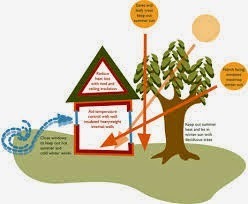 Passive can be active.
Passive can be active.Natural gas to heat water will be replaced by solar hot water, heat pump hot water heaters, or a combination of the two.
Natural gas used to generate electricity will be replaced by wind, solar and reduced consumption through energy efficiency.
 Desert EnergyIt turns out natural gas (methane) is not the clean energy we thought. Our natural gas production system leaks 6-12% of the methane it produces and is estimated to be responsible for 30% of all methane the US emits. It's better than coal, yes, but it will have to be replaced just the same. Some of this new electricity generation will be distributed (rooftop solar PV) and some will be utility-scale. For new utility-scale generation, depending on the location, wind and solar are already at cost parity with natural gas. The exchange of renewables for natural gas will happen first in places with great sun or onshore wind. (Sun—most western, Midwestern, southern, and coastal mid-Atlantic states, all the way up to Connecticut and Rhode Island. Onshore wind—most Midwestern and western states.) There are some states (LA, WY, ND, SD) that have excellent renewable resources but will be slow to the party because they will remain stubbornly committed to their fossil fuel industry. However, they too will eventually convert, and, ironically, Wyoming and the Dakotas will make more money from wind over the next 100 years than they did from fossil fuels the previous 100.
Desert EnergyIt turns out natural gas (methane) is not the clean energy we thought. Our natural gas production system leaks 6-12% of the methane it produces and is estimated to be responsible for 30% of all methane the US emits. It's better than coal, yes, but it will have to be replaced just the same. Some of this new electricity generation will be distributed (rooftop solar PV) and some will be utility-scale. For new utility-scale generation, depending on the location, wind and solar are already at cost parity with natural gas. The exchange of renewables for natural gas will happen first in places with great sun or onshore wind. (Sun—most western, Midwestern, southern, and coastal mid-Atlantic states, all the way up to Connecticut and Rhode Island. Onshore wind—most Midwestern and western states.) There are some states (LA, WY, ND, SD) that have excellent renewable resources but will be slow to the party because they will remain stubbornly committed to their fossil fuel industry. However, they too will eventually convert, and, ironically, Wyoming and the Dakotas will make more money from wind over the next 100 years than they did from fossil fuels the previous 100.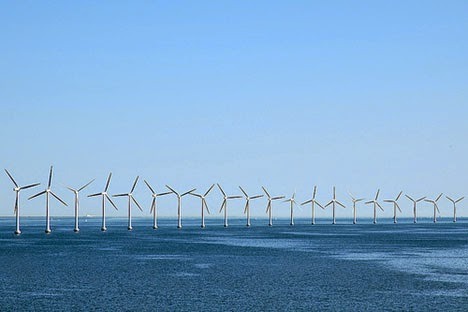 Danish EnergyCompared to Europe, the US has been quite sluggish with offshore wind. Eventually those states with access to decent amounts of offshore wind (most coastal states except Florida, and most states adjoining the Great Lakes) will use it to create electricity, although their path will be bumpier than the states with good sun and/or onshore wind. There will likely be some use of geothermal, tidal, biomass, and hydroelectric, but solar and wind will make up the lion’s share of electricity generation. So which states are going to have the most trouble switching from fossil fuels? As I see it, there are only four states that will have some difficulty substituting for fossil fuels due to lack of prolific sun/wind--Ohio, Vermont (although this state can probably buy wind electricity from its neighbors), Pennsylvania, and West Virginia (although this has a few nice wind pockets.) Any state that drags its heels on the transition will invariably inflict pain on itself.
Danish EnergyCompared to Europe, the US has been quite sluggish with offshore wind. Eventually those states with access to decent amounts of offshore wind (most coastal states except Florida, and most states adjoining the Great Lakes) will use it to create electricity, although their path will be bumpier than the states with good sun and/or onshore wind. There will likely be some use of geothermal, tidal, biomass, and hydroelectric, but solar and wind will make up the lion’s share of electricity generation. So which states are going to have the most trouble switching from fossil fuels? As I see it, there are only four states that will have some difficulty substituting for fossil fuels due to lack of prolific sun/wind--Ohio, Vermont (although this state can probably buy wind electricity from its neighbors), Pennsylvania, and West Virginia (although this has a few nice wind pockets.) Any state that drags its heels on the transition will invariably inflict pain on itself. Natural gas to make nitrogren-based fertilizer will be replaced by wind-powered electrolytic nitrogen-based fertilizer production, as well as by compost, worms, green manure, animal manure, crop rotation and other permaculture techniques.
 We don't have to starve.Currently the hydrogen in the natural gas molecule is used to pull nitrogen out of the atmosphere to make ammonia and other nitrogen-based fertilizers. But nitrogen can also be pulled from the air by a reaction with hydrogen split from water molecules through electrolysis. Electrolysis can easily be powered by wind, especially at night when the wind blows strongest and other demand for electricity is low. Though the US imports a lot of its nitrogen-based fertilizers at the moment, the fertilizer we do produce is largely made in Louisiana, Oklahoma and Texas. Oklahoma and Texas are windy states. Excess night wind there can be cheaply directed to nitrogen fertilizer production. For growing grains and soy in the quantities necessary to feed the planet, I expect nitrogen-based fertilizer will still be necessary. However, for fruits and vegetables on your average (electric) truck farm, compost and permaculture techniques can avoid (or at least vastly reduce) the need for chemical fertilizer. While it's best not to waste food, unless you have hogs or chickens around, you're going to have to do something with food scraps and paper packaging refuse. In towns and cities they can be turned into rich compost that permaculture farmers love.
We don't have to starve.Currently the hydrogen in the natural gas molecule is used to pull nitrogen out of the atmosphere to make ammonia and other nitrogen-based fertilizers. But nitrogen can also be pulled from the air by a reaction with hydrogen split from water molecules through electrolysis. Electrolysis can easily be powered by wind, especially at night when the wind blows strongest and other demand for electricity is low. Though the US imports a lot of its nitrogen-based fertilizers at the moment, the fertilizer we do produce is largely made in Louisiana, Oklahoma and Texas. Oklahoma and Texas are windy states. Excess night wind there can be cheaply directed to nitrogen fertilizer production. For growing grains and soy in the quantities necessary to feed the planet, I expect nitrogen-based fertilizer will still be necessary. However, for fruits and vegetables on your average (electric) truck farm, compost and permaculture techniques can avoid (or at least vastly reduce) the need for chemical fertilizer. While it's best not to waste food, unless you have hogs or chickens around, you're going to have to do something with food scraps and paper packaging refuse. In towns and cities they can be turned into rich compost that permaculture farmers love.Coal and natural gas used to generate electricity to power standard air conditioning will be replaced by heat pumps, whole house fans, and ceiling fans that require much lower energy inputs.
 Energy saver78 degrees with a ceiling fan running is very pleasant for most activities as long as some of the humidity has been taken out of the air. (Heat pumps take humidity out of the air better than standard air conditioning.) In all but times of high humidity, using a whole house fan to exhaust hot air and bring in cool air at night is a nearly free form of air conditioning. Add on shade trees, awnings, etc. And turn down the temps in commercial buildings! You shouldn't have to wear a parka to go grocery shopping or watch a movie in the middle of summer.
Energy saver78 degrees with a ceiling fan running is very pleasant for most activities as long as some of the humidity has been taken out of the air. (Heat pumps take humidity out of the air better than standard air conditioning.) In all but times of high humidity, using a whole house fan to exhaust hot air and bring in cool air at night is a nearly free form of air conditioning. Add on shade trees, awnings, etc. And turn down the temps in commercial buildings! You shouldn't have to wear a parka to go grocery shopping or watch a movie in the middle of summer.Coal and natural gas used to create electricity to power second refrigerators will be replaced by nothing.
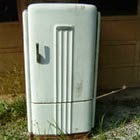 Energy suckerElectricity costs will rise (or Americans will get poorer) until it becomes too expensive to run a fifteen-year-old second refrigerator in the garage. When all those second refrigerators go away, that will be a good indication our energy is priced correctly because it will mean energy is no longer cheap enough to waste.
Energy suckerElectricity costs will rise (or Americans will get poorer) until it becomes too expensive to run a fifteen-year-old second refrigerator in the garage. When all those second refrigerators go away, that will be a good indication our energy is priced correctly because it will mean energy is no longer cheap enough to waste. Oil (gasoline) used to power private vehicles will be replaced by public and private transit, bicycles, walking, and people choosing to live closer to jobs, goods and services.
 A veritable chariotIt takes a heck of a lot of energy to propel 3000-5000 pounds of steel around. We will see the reemergence of rail for distances of 30–1000 miles. We will see most people figuring out how to commute by methods other than private car. We will see communities begin to orient themselves to making walking and biking safe and convenient for short trips. We will see cities and towns focus on their core again, drawing economic activity, housing and jobs towards the center rather continually expanding along the periphery, which will make these cities and towns financially stronger. (See Strongtowns.org) Electric bikes sales are already up, and electric adult trikes for seniors will become quite popular. The good news is that all this will make the 80% of Americans who are currently unhealthy due to their sedentary way of life a heck of a lot healthier.
A veritable chariotIt takes a heck of a lot of energy to propel 3000-5000 pounds of steel around. We will see the reemergence of rail for distances of 30–1000 miles. We will see most people figuring out how to commute by methods other than private car. We will see communities begin to orient themselves to making walking and biking safe and convenient for short trips. We will see cities and towns focus on their core again, drawing economic activity, housing and jobs towards the center rather continually expanding along the periphery, which will make these cities and towns financially stronger. (See Strongtowns.org) Electric bikes sales are already up, and electric adult trikes for seniors will become quite popular. The good news is that all this will make the 80% of Americans who are currently unhealthy due to their sedentary way of life a heck of a lot healthier. Already Millennials (the under 30 crowd) are giving up car ownership to live in walkable, bikeable urban areas with transit. (This is partly due to crushing student debt that has made them poorer.) Next will be retiring Boomers who all of the sudden don't "want" the hassle (and expense) of driving everywhere. Also, since Boomers are the biggest car-driving generation, as they die off, car use will die off as well. (Note: I am a tail-end boomer. I hope to be on an adult trike when I'm eighty.)
Already Millennials (the under 30 crowd) are giving up car ownership to live in walkable, bikeable urban areas with transit. (This is partly due to crushing student debt that has made them poorer.) Next will be retiring Boomers who all of the sudden don't "want" the hassle (and expense) of driving everywhere. Also, since Boomers are the biggest car-driving generation, as they die off, car use will die off as well. (Note: I am a tail-end boomer. I hope to be on an adult trike when I'm eighty.)Oil (gasoline) used to power private vehicles will be replaced by electric cars for a small percentage of the population.
 In your future?People that already can’t afford $26-$32K for an electric car are unlikely to be able to afford one in the near or mid future. This is not a terrible thing—we need to be putting our electric capacity towards powering heat pumps and producing fertilizer, not moving 3000 pound blobs of steel around everywhere. Over the next five years, most households will drop to one car; the following five years half will drop to zero, and the households that have a car will use it sparingly. Widespread use of personal cars might develop again on the other side of the transition when enough solar and wind electricity generation has been built out, but for a decade (or two?) cars will likely be small, lightweight, pod-like things that are largely a luxury item. (They may, however, come when you whistle.) In the near future we may see some increased use of neighborhood electric vehicles (Cost: $12,000, 25mph top speed) and electric cars as part of carsharing programs.
In your future?People that already can’t afford $26-$32K for an electric car are unlikely to be able to afford one in the near or mid future. This is not a terrible thing—we need to be putting our electric capacity towards powering heat pumps and producing fertilizer, not moving 3000 pound blobs of steel around everywhere. Over the next five years, most households will drop to one car; the following five years half will drop to zero, and the households that have a car will use it sparingly. Widespread use of personal cars might develop again on the other side of the transition when enough solar and wind electricity generation has been built out, but for a decade (or two?) cars will likely be small, lightweight, pod-like things that are largely a luxury item. (They may, however, come when you whistle.) In the near future we may see some increased use of neighborhood electric vehicles (Cost: $12,000, 25mph top speed) and electric cars as part of carsharing programs. Already available for neighborhood driving Note: 96,000 electric plug-in cars of one kind or another were sold in the US in 2013. Cumulatively, the US has 170,000 electric cars on the road. Even if plug-in electric cars sales
doubled
every year for the next six years (and they don’t appear to be on that track for 2014--April year to date numbers are up only 20% over 2013 April YTD) that would mean by 2020 we would have roughly 13 million electric cars on the road out of a fleet of 250 million total cars. Which means only 5% of the US vehicle fleet would be electric. Even if every American household got by with one less car (while electric car sales doubled each year) by 2020 only 10% of the vastly reduced number of cars would be electric.
Already available for neighborhood driving Note: 96,000 electric plug-in cars of one kind or another were sold in the US in 2013. Cumulatively, the US has 170,000 electric cars on the road. Even if plug-in electric cars sales
doubled
every year for the next six years (and they don’t appear to be on that track for 2014--April year to date numbers are up only 20% over 2013 April YTD) that would mean by 2020 we would have roughly 13 million electric cars on the road out of a fleet of 250 million total cars. Which means only 5% of the US vehicle fleet would be electric. Even if every American household got by with one less car (while electric car sales doubled each year) by 2020 only 10% of the vastly reduced number of cars would be electric. Way easier than an axe. Oil (gasoline or diesel) used to power lawnmowers, chainsaws, snowblowers, leafblowers etc will be replaced by electric version of same, or by rakes, shovels, brooms, pushmowers, etc., or by not mowing the grass, cutting the wood, blowing the leaves and snow, etc. Note: chopped leaves make great mulch.
Way easier than an axe. Oil (gasoline or diesel) used to power lawnmowers, chainsaws, snowblowers, leafblowers etc will be replaced by electric version of same, or by rakes, shovels, brooms, pushmowers, etc., or by not mowing the grass, cutting the wood, blowing the leaves and snow, etc. Note: chopped leaves make great mulch. Rubber meets road.Oil (bitumen) used to make asphalt will largely be replaced by recycled asphalt, recycled rubber from used tires, and fewer paved roads in general.
Rubber meets road.Oil (bitumen) used to make asphalt will largely be replaced by recycled asphalt, recycled rubber from used tires, and fewer paved roads in general.Paved roads are hugely expensive, and right now much of them are largely financed by the federal government, which pays for them with debt. (The gas tax hasn't risen since 1993, but road repair prices sure have!) Coming soon, most roads/highways/freeways between towns/cities will be user-fee funded through tolls or a vehicle mileage tax. Since local roads will be the responsibility of cities/towns, the only ones that will be maintained are those where population density is high enough to pay for them. On the up side, the roads will be more bouncy. (This actually great for joggers.)
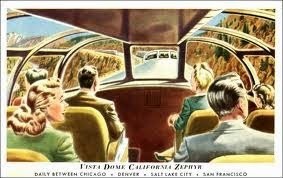 Ooh, a dome car!Oil (kerosene) used to power airplanes will somewhat be replaced by train travel and a limited amount of bio-jet fuel.
Ooh, a dome car!Oil (kerosene) used to power airplanes will somewhat be replaced by train travel and a limited amount of bio-jet fuel.
 We could do this.Plane travel is going to get expensive. That’s all there is to it. Per passenger mile, a diesel train with high occupancy is four times as energy efficient as a plane with similar occupancy. An electrified passenger rail system comparable to those used in Europe and Japan uses just 10% of the energy of planes for the same distance. The good news is there will be huge incentive to get our rail system up to at least 100-120mph, a speed that is considered slow in Europe, China and Japan, but would be double what we are currently managing. The bad news is people are likely going to travel fewer total miles over the course of their lives. That doesn’t mean zero travel, just less. Between 1870 and 1950 Americans traveled a remarkable amount by means other than airplanes and personal cars. Most of the long distance miles were by rail. Of course rail could be very pleasant, then. (Check out Mark Twain's comparison of journeys by stage coach and railroad.)
We could do this.Plane travel is going to get expensive. That’s all there is to it. Per passenger mile, a diesel train with high occupancy is four times as energy efficient as a plane with similar occupancy. An electrified passenger rail system comparable to those used in Europe and Japan uses just 10% of the energy of planes for the same distance. The good news is there will be huge incentive to get our rail system up to at least 100-120mph, a speed that is considered slow in Europe, China and Japan, but would be double what we are currently managing. The bad news is people are likely going to travel fewer total miles over the course of their lives. That doesn’t mean zero travel, just less. Between 1870 and 1950 Americans traveled a remarkable amount by means other than airplanes and personal cars. Most of the long distance miles were by rail. Of course rail could be very pleasant, then. (Check out Mark Twain's comparison of journeys by stage coach and railroad.)Oil (diesel) used to transport freight via trucking will be replaced by rail.
Already happening because per ton of cargo moved, rail uses one-fifth the energy of trucking. Demand for rail freight is growing by leaps and bounds. However, currently 40% of rail freight capacity is consumed by coal shipments. Take coal out of the picture and there’s lots of capacity to be had.
Oil (diesel) used to power rail will be replaced by electrified rail.
 Electrify it.Electrified rail uses up to 2/3rds less energy than diesel rail. (So electrified rail uses 6-7% of the energy that diesel trucking does to move the same load.)
Electrify it.Electrified rail uses up to 2/3rds less energy than diesel rail. (So electrified rail uses 6-7% of the energy that diesel trucking does to move the same load.)Oil (heating oil) used to heat homes will be replaced by heat pumps.
This substitution has been underway for years and is almost complete.
Oil (liquid petroleum gases) used to create plastics will somewhat be replaced by organic packaging materials and/or glass, metal, etc.
 Plastic world.Sure, some plastics for some purposes are very useful and will no doubt continue. But this county at the moment is drowning in cheap plastic that is going to disappear like Karl the Fog in the morning sunshine.
Plastic world.Sure, some plastics for some purposes are very useful and will no doubt continue. But this county at the moment is drowning in cheap plastic that is going to disappear like Karl the Fog in the morning sunshine.Oil (gasoline) used to make drive-till-you-qualify McMansions sellable will be replaced by smaller homes in dense, walkable neighborhoods.
 Back to the future.Cities and towns with a central dense, walkable, livable core where it is possible to easily live car-free will do well economically. Small towns with some type of central core and some local economic base (manufacturing? agriculture?) connected by rail to other areas will also do okay. The best predictor of economic prosperity will be the economic output a region/city/town can produce per unit of energy the region consumes.
Back to the future.Cities and towns with a central dense, walkable, livable core where it is possible to easily live car-free will do well economically. Small towns with some type of central core and some local economic base (manufacturing? agriculture?) connected by rail to other areas will also do okay. The best predictor of economic prosperity will be the economic output a region/city/town can produce per unit of energy the region consumes. 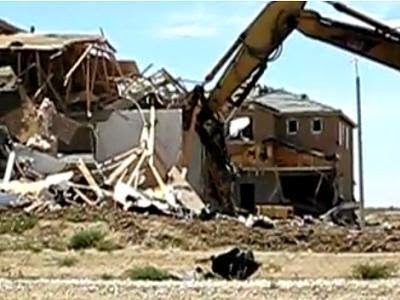 Future farmland?Car dependent suburbs, on the other hand, with no transit links to anywhere else (and no hope of transit links because of low density,) will grow more and more unpopular. They will be scavenged/abandoned/become the new slums where the poorest people will be pushed to. It will happen to those suburbs farthest on the periphery first, and in fact this is already in process. Some areas will be bulldozed, some areas will be returned to farmland, some areas will be allowed to rot, burn, become crime/gang ridden. This is not going to be pretty. Note: I grew up in suburbia.
Future farmland?Car dependent suburbs, on the other hand, with no transit links to anywhere else (and no hope of transit links because of low density,) will grow more and more unpopular. They will be scavenged/abandoned/become the new slums where the poorest people will be pushed to. It will happen to those suburbs farthest on the periphery first, and in fact this is already in process. Some areas will be bulldozed, some areas will be returned to farmland, some areas will be allowed to rot, burn, become crime/gang ridden. This is not going to be pretty. Note: I grew up in suburbia.Oil (diesel) used to bus children long distances to school will be replaced by children attending schools they can walk or bike to.
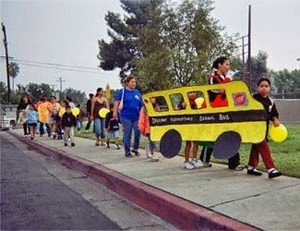 Walking school bus.Can your children walk or bike to school? (Or could they if the streets were less dangerous?) Can they reach school by public transportation? If you have children and the answer to both is no, you will probably move within three years to someplace where the answer is yes. (Note: your children don't actually have to walk with a cardboard cut-out of a bus.)
Walking school bus.Can your children walk or bike to school? (Or could they if the streets were less dangerous?) Can they reach school by public transportation? If you have children and the answer to both is no, you will probably move within three years to someplace where the answer is yes. (Note: your children don't actually have to walk with a cardboard cut-out of a bus.)Oil (diesel) used to power farm equipment will be replaced by electrified farm equipment.
There are already people out there converting old tractors to electricity. Others have produced new electric tractors. (See video above. Love the drawl.). There are already companies making electric utility tractors that can mow, scrape and blow snow, tow things around etc. (See video below. I want one of these beauties even though I have no lawn, I live where it doesn't snow, and my entire yard is nearly vertical.) Electric motors actually have the advantage of more torque than internal combustion motors, and battery weight can be very useful in adding traction.
Oil (diesel) used to power heavy trucks (like buses and garbage trucks) that travel under 100 miles a day will be replaced by electric heavy trucks.
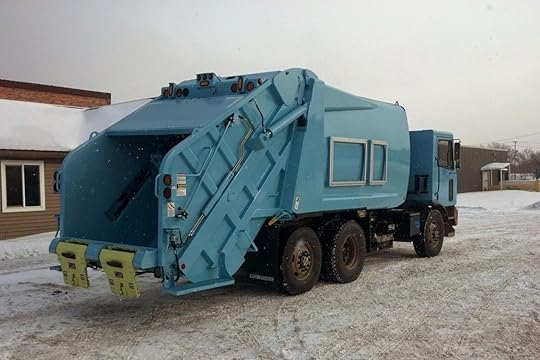 All-electric, baby.There’s already a company that makes electric garbage trucks, school buses, shuttle buses and other heavy trucks. They are twice the cost of a diesel-powered version but come out even financially over ten years because due to lower operating expenses. (Electric motors require little maintenance.) The city of Chicago has order twenty of these garbage trucks. If they can handle garbage in Chicago, I'd guess they can handle garbage anywhere.
All-electric, baby.There’s already a company that makes electric garbage trucks, school buses, shuttle buses and other heavy trucks. They are twice the cost of a diesel-powered version but come out even financially over ten years because due to lower operating expenses. (Electric motors require little maintenance.) The city of Chicago has order twenty of these garbage trucks. If they can handle garbage in Chicago, I'd guess they can handle garbage anywhere.Oil (diesel and gasoline) used to transport goods the last few miles to their destination will be replaced by small electric trucks, electric vans and electric bicycles.
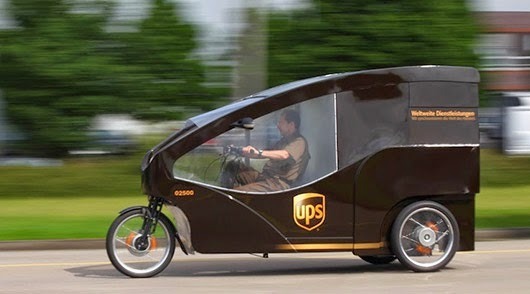 Speedy delivery.We’re already starting to see light items like pizzas, take out, and flowers delivered by bicycle. An electric bicycle can tote 500lbs even uphill. Freight delivered by rail will be unloaded by electric forklifts onto large electric trucks to warehouses that will later load onto small electric delivery trucks.
Speedy delivery.We’re already starting to see light items like pizzas, take out, and flowers delivered by bicycle. An electric bicycle can tote 500lbs even uphill. Freight delivered by rail will be unloaded by electric forklifts onto large electric trucks to warehouses that will later load onto small electric delivery trucks. Oil (diesel) used to transport low-value, heavy items, especially liquids like soda pop and bottled water, will be replaced by nothing.
People will make their own soda and/or get a water filter. The good news is locally brewed beer will become quite economic. Perhaps even local soda fountains will spring up again.
Oil, electricity and natural gas used to dig up, transport, and process fossil fuels will be replaced by nothing.
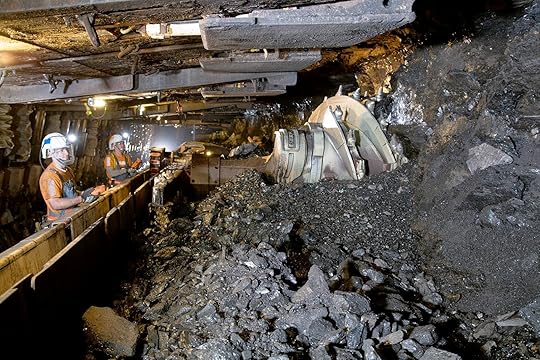 Energy-intensiveIt takes energy to get energy. Lots and lots of energy is used to frack, mine, pump, and refine. (Oil refining alone comprises 3% of our nation’s total energy consumption.) As time goes on and the easy oil and natural gas is all pumped out and the best coal nearest the surface all mined, it takes more energy to get our energy, leaving less for us to use for other things. This ratio is called the energy returned on energy invested (EROEI). It used to be it took one barrel of oil to get a hundred. We’d write that EROEI as 100:1. Now one barrel of oil gets ten, 10:1. It takes as much energy to make corn-based ethanol as we get from burning the ethanol in an engine, 1:1. (Ahem, why exactly do we bother?) In contrast, in a 2011 analysis of biodiesel in Vermont, the EROEI of biodiesel from sunflower seeds ran on average around 4:1.
Energy-intensiveIt takes energy to get energy. Lots and lots of energy is used to frack, mine, pump, and refine. (Oil refining alone comprises 3% of our nation’s total energy consumption.) As time goes on and the easy oil and natural gas is all pumped out and the best coal nearest the surface all mined, it takes more energy to get our energy, leaving less for us to use for other things. This ratio is called the energy returned on energy invested (EROEI). It used to be it took one barrel of oil to get a hundred. We’d write that EROEI as 100:1. Now one barrel of oil gets ten, 10:1. It takes as much energy to make corn-based ethanol as we get from burning the ethanol in an engine, 1:1. (Ahem, why exactly do we bother?) In contrast, in a 2011 analysis of biodiesel in Vermont, the EROEI of biodiesel from sunflower seeds ran on average around 4:1. How low can our EROEI ratios go? Some people believe it takes at least 6:1 to provide enough energy surplus for civilization to work. Right now EROEI is 6 or 7:1 for solar pv,18-20:1 for wind, and 5:1 for nuclear energy. (EROEI is rising for solar as the technology matures.) Tar sands and fracked tight oil both take a lot of energy to produce. Both have an EROEI around 5:1.
Oil (bunker fuel) used to power ships will be replaced by a combination of rigid sails, solar power, and hydrogen fuel cells.
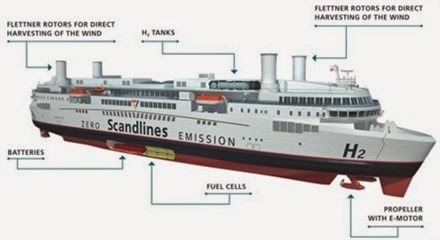 Hydrogen shippingIt takes more energy to produce hydrogen as a stored fuel than you get from the fuel, so a hydrogen fuel cell is not a fuel source but rather just a big battery. But ships could load on enough hydrogen at ports to get them across the ocean in a reasonable amount of time. As fuel costs rise, there is also likely to be just less overseas shipping altogether as local production of goods will outweigh labor price arbitrage between rich and poor nations.
Hydrogen shippingIt takes more energy to produce hydrogen as a stored fuel than you get from the fuel, so a hydrogen fuel cell is not a fuel source but rather just a big battery. But ships could load on enough hydrogen at ports to get them across the ocean in a reasonable amount of time. As fuel costs rise, there is also likely to be just less overseas shipping altogether as local production of goods will outweigh labor price arbitrage between rich and poor nations.Oil and natural gas used to grow corn for ethanol won’t be replaced.
Oil and natural gas used to grow corn for animal feed and soda pop mostly won’t be replaced.
 Nutrition-free caloriesOil and natural gas used to grow grains that are turned into processed food with little or no nutrition but that contain lots of obesity-making calories won’t be replaced.
Nutrition-free caloriesOil and natural gas used to grow grains that are turned into processed food with little or no nutrition but that contain lots of obesity-making calories won’t be replaced. China added a record 12GW of solar capacity in 2013.Coal used to create electricity will be replaced by renewables.This will happen even in China. The question is will it happen quickly enough. The US can hardly pressure/negotiate with China to reduce carbon emissions if we won't agree to do so ourselves. The good news is that China finally seems to be a teensy bit concerned that the air in Beijing is thick enough to cut with a fork and knife.
China added a record 12GW of solar capacity in 2013.Coal used to create electricity will be replaced by renewables.This will happen even in China. The question is will it happen quickly enough. The US can hardly pressure/negotiate with China to reduce carbon emissions if we won't agree to do so ourselves. The good news is that China finally seems to be a teensy bit concerned that the air in Beijing is thick enough to cut with a fork and knife.As outlined for natural gas, coal to generate electricity will be replaced in states with great sun and onshore wind first, states with offshore wind second, and states that love their coal industry last. Already the cost of shipping coal is higher than the cost of the coal itself for some states in the South. The cost of delivered coal nearly doubled between 2004 and 2011, and coal-burning power plants are under pressure because of the toxic substances and particulate matter they produce, as well as the greenhouse gases. The big coal burning states left are: PA, IL, IN, MI, OH, WI, IA, KS, MO, NE, ND, FL, GA, WV, AL, KY, TN, AR, OK, TX, AZ, CO, and WY. If you live in any of these 23 states, your electricity system has a lot of change ahead of it but the end result will be better for your lungs.
Coal, natural gas and oil used to power waste will not be replaced.
It would, of course, be quite expensive to replace all our current energy use with renewables over such a short time span. The good news is that we don’t have to—we only need to replace about half, since the rest of our energy consumption is largely waste in one form or another and much of it is easy to reduce. Admittedly waste is in the eye of the beholder, but other countries that arguably have higher standards of living than we do already manage to use half the energy per person as the US, showing that we have a great deal of energy fat we can burn off without much harm.
 Before we’re through this next decade of transition we will likely see: --Square feet of living space per person drop from 1000 back to 500--Vehicle miles traveled per capita drop from 9400 to 4000--Vehicles per household drop from 1.86 to .56--the percent of households with one or fewer vehicles will climb from 40% to 90%--areas with more than 50 days/year of +105 temps or thirty days/year of +115 temps largely abandoned--many coastal areas that have already experienced flooding due to storm surges largely abandoned or repurposed to wetlands and/or barrier islands
Before we’re through this next decade of transition we will likely see: --Square feet of living space per person drop from 1000 back to 500--Vehicle miles traveled per capita drop from 9400 to 4000--Vehicles per household drop from 1.86 to .56--the percent of households with one or fewer vehicles will climb from 40% to 90%--areas with more than 50 days/year of +105 temps or thirty days/year of +115 temps largely abandoned--many coastal areas that have already experienced flooding due to storm surges largely abandoned or repurposed to wetlands and/or barrier islands
 --most current trucks, SUVs and vans become recycled steel--LED street lamps and bulbs--elimination of most paid storage/self-storage units--smaller refrigerators (16 cubic feet or less)--resurgence of preserving, pickling and canning--trips under a mile routinely walked--trips under three miles routinely walked/biked/taken by transit--3/4ths of all trips will be under three miles--90% of trips by means other than personal car--less in the way of imported foods--seasonal, locally produced fruits and vegetables
--most current trucks, SUVs and vans become recycled steel--LED street lamps and bulbs--elimination of most paid storage/self-storage units--smaller refrigerators (16 cubic feet or less)--resurgence of preserving, pickling and canning--trips under a mile routinely walked--trips under three miles routinely walked/biked/taken by transit--3/4ths of all trips will be under three miles--90% of trips by means other than personal car--less in the way of imported foods--seasonal, locally produced fruits and vegetables--home and community food gardens (see great Guerilla Gardening video below!)
--truck farms and greenhouses again outside every major city--food waste reduced from 40% to 5%--much less beef consumed and less meat in general--elimination of surface parking lots from most cities
 Coming soon.--most large malls abandoned or converted to other uses.--most strip malls abandoned or redeveloped with housing, ground floor retail and no parking lot--most things in your home that now say “Made in China” produced locally (and cost twice as much) or not available at all--resurgence of intergenerational households--most fast food, if it exists, will be local. National chains will dry up due to economics and distribution problems.--Few ultra low cost national retail chains for the same reason.--more small businesses and small business owners--more repair shops for things we now throw away when they get old/break (watches, shoes, appliances)
Coming soon.--most large malls abandoned or converted to other uses.--most strip malls abandoned or redeveloped with housing, ground floor retail and no parking lot--most things in your home that now say “Made in China” produced locally (and cost twice as much) or not available at all--resurgence of intergenerational households--most fast food, if it exists, will be local. National chains will dry up due to economics and distribution problems.--Few ultra low cost national retail chains for the same reason.--more small businesses and small business owners--more repair shops for things we now throw away when they get old/break (watches, shoes, appliances)
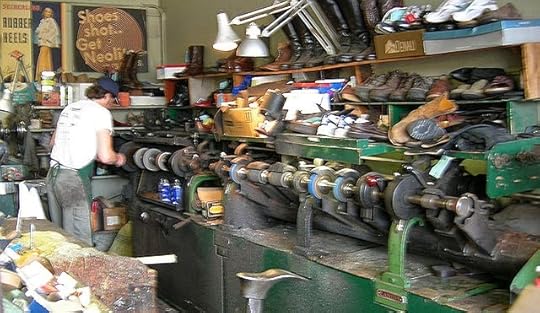 Almost a lost art.--most auto infrastructure turned into other uses—gas stations, auto dealerships, parking structures, parking lots, muffler shops, auto body shops, auto repair shops, etc.--30% of US population employed in manufacturing or agriculture (up from 16.5% now)--9% of population employed in retail or food services (down from 17% now)--5% of population employed in healthcare (down from 10% now)--small towns connected by rail to larger population centers doing quite well
Almost a lost art.--most auto infrastructure turned into other uses—gas stations, auto dealerships, parking structures, parking lots, muffler shops, auto body shops, auto repair shops, etc.--30% of US population employed in manufacturing or agriculture (up from 16.5% now)--9% of population employed in retail or food services (down from 17% now)--5% of population employed in healthcare (down from 10% now)--small towns connected by rail to larger population centers doing quite well
 --walkable, bedroom suburbs connected by rail to cities doing quite well--fewer second homes/vacation homes or even separate retirement communities--Las Vegas? It could disappear, or it could be retained as the one insane, ridiculously extravagant, energy-guzzling reminder of what we once were. (Nevada has little water but it does have excellent solar.) I’ll let you decide.--much less in the way of cheap plastic stuff from China--3/4ths reduction in non-nutritional calories consumed--1/2 reduction in money spent on health care (not through Obamacare—real healthcare reform is still ahead of us)--2/3rds reduction in prescription drugs consumed
--walkable, bedroom suburbs connected by rail to cities doing quite well--fewer second homes/vacation homes or even separate retirement communities--Las Vegas? It could disappear, or it could be retained as the one insane, ridiculously extravagant, energy-guzzling reminder of what we once were. (Nevada has little water but it does have excellent solar.) I’ll let you decide.--much less in the way of cheap plastic stuff from China--3/4ths reduction in non-nutritional calories consumed--1/2 reduction in money spent on health care (not through Obamacare—real healthcare reform is still ahead of us)--2/3rds reduction in prescription drugs consumed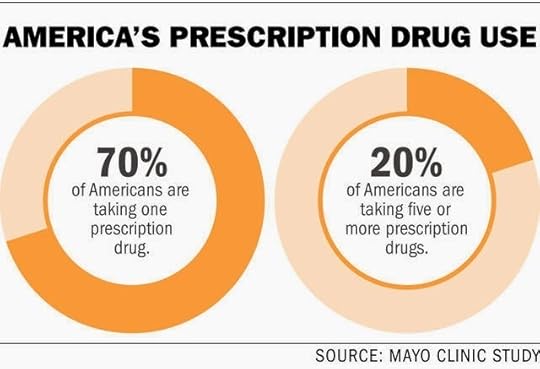 --2/3rds reduction in money spent on higher education--3/4ths reduction in golf courses (they will make excellent spots for local permaculture)--1/2 reduction in money spent on defense--1/2 reduction on money spent by the federal government overall
--2/3rds reduction in money spent on higher education--3/4ths reduction in golf courses (they will make excellent spots for local permaculture)--1/2 reduction in money spent on defense--1/2 reduction on money spent by the federal government overallSo by 2020 most people reading this article today will have a different form of space and water heating, will not use a personal car for most trips, will live within five miles of some kind of light or heavy rail (either by moving or by rail extending to them), will live within three miles of a store(s) that provide most of their provisions, and will grow some of their own food. They will get on a plane no more than once a year, if that. Some of their transportation will be powered by a lithium iron battery. Half will have solar PV and/or solar hot water panels on their rooftops. Sounds like a lot of change indeed.
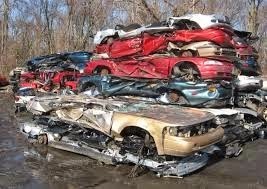 Now you might be wondering, just where are we going to get the energy and raw materials to produce all the wind turbines and solar panels we will need? Well, first off, we have a heck of a lot of steel in the form of cars that will soon be jettisoned by households all over the country. (250 million cars x 3000lbs steel=750 billions lbs. The US currently uses about 200 billion lbs of steel a year, one fourth of it going to cars. A 1MW wind turbine takes about 200,000 lbs of steel, or about 67 cars' worth.) It takes much less energy to recycle steel than make it new from its component ores.
Now you might be wondering, just where are we going to get the energy and raw materials to produce all the wind turbines and solar panels we will need? Well, first off, we have a heck of a lot of steel in the form of cars that will soon be jettisoned by households all over the country. (250 million cars x 3000lbs steel=750 billions lbs. The US currently uses about 200 billion lbs of steel a year, one fourth of it going to cars. A 1MW wind turbine takes about 200,000 lbs of steel, or about 67 cars' worth.) It takes much less energy to recycle steel than make it new from its component ores.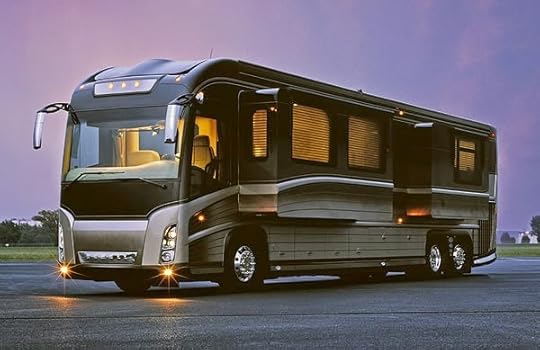 300K RVs=how many solar panels?Secondly, all the money and energy that now go into producing automobiles, trucks, jet skis, powerboats, snowmobiles, RVs, auto parts, internal combustion engines of any kind, soda pop, ethanol and a huge percentage of pharmaceuticals can be freed up to manufacture solar panels, wind turbines, electric bicycles, regular bicycles, rail cars, and light rail cars. And since everyone will be buying less new stuff for a while (relying instead on repairing what they have or purchasing used items from local flea markets or Craigslist supplied by a steady flow of the contents of self-storage units) less new stuff will need to be made or transported, saving energy. Until we get through the transition, there will likely be less consumption of luxuries, especially those that require a lot of energy. Fewer trips to Disneyland, Europe and Las Vegas. (More camping and visiting relatives.) Less eating out, fewer vacation homes, fewer plastic surgeries. No more spending $1000 on a high school prom. (Holy Toledo, the average amount a high school prom attendee spends right now is $1139!) Young people seem willing to give up a car rather than cell phones or internet, so my guess is by hook or crook both of those will remain fixtures of American life, although I can’t see cell phone plans continuing to cost nearly as much as they do now.
300K RVs=how many solar panels?Secondly, all the money and energy that now go into producing automobiles, trucks, jet skis, powerboats, snowmobiles, RVs, auto parts, internal combustion engines of any kind, soda pop, ethanol and a huge percentage of pharmaceuticals can be freed up to manufacture solar panels, wind turbines, electric bicycles, regular bicycles, rail cars, and light rail cars. And since everyone will be buying less new stuff for a while (relying instead on repairing what they have or purchasing used items from local flea markets or Craigslist supplied by a steady flow of the contents of self-storage units) less new stuff will need to be made or transported, saving energy. Until we get through the transition, there will likely be less consumption of luxuries, especially those that require a lot of energy. Fewer trips to Disneyland, Europe and Las Vegas. (More camping and visiting relatives.) Less eating out, fewer vacation homes, fewer plastic surgeries. No more spending $1000 on a high school prom. (Holy Toledo, the average amount a high school prom attendee spends right now is $1139!) Young people seem willing to give up a car rather than cell phones or internet, so my guess is by hook or crook both of those will remain fixtures of American life, although I can’t see cell phone plans continuing to cost nearly as much as they do now.And then there's all the money we spend on health care--close to 20% of every dollar spent in America! It is a hellacious amount of money, and all we have to show for it is a population of whom 70% are in chronic poor health. If we simply designed thirty minutes of walking into daily life and junk food disappeared, we could cut health care spending in half, people wouldn't need 2/3rds of the medical procedures, test or drugs they take, and Americans would be a great deal happier and healthier than they are today.
 This is insane.
This is insane.I know that most Americans (98%?) will think what I’m talking about here is nuts. Americans will never agree to such lifestyle changes so they simply won’t happen. Somehow someone will figure something out (!), and our energy-slurping, carbon-spewing way of life will continue blithely on. To those folks, I am an off-the-charts doomer whose negativity is at best un-American and possibly dangerous. I should stop ruminating on these matters and dose myself heavily with Xanax.
 Happy Land.A small (<1?) percent of the population who, through examination of the data, have become fatalistic about peak oil and/or climate change will think I am far too optimistic. From their perspective there is no way to achieve a civilization that operates within the planet’s ability to sustain us, or even if there might be, energy will run out and/or the climate will clobber us before we can develop it. These folks are certain near-term extinction, or at least total societal collapse and massive depopulation, is a done deal. Baked in the cake. Therefore it's not worth any effort to attempt to prevent such an outcome. Compared to these folks, I am a pie-in-the-sky rainbow and unicorn fantasist who should realize all her ideas about how to produce enough renewable energy to power a civilization are futile, perky, and annoying.
Happy Land.A small (<1?) percent of the population who, through examination of the data, have become fatalistic about peak oil and/or climate change will think I am far too optimistic. From their perspective there is no way to achieve a civilization that operates within the planet’s ability to sustain us, or even if there might be, energy will run out and/or the climate will clobber us before we can develop it. These folks are certain near-term extinction, or at least total societal collapse and massive depopulation, is a done deal. Baked in the cake. Therefore it's not worth any effort to attempt to prevent such an outcome. Compared to these folks, I am a pie-in-the-sky rainbow and unicorn fantasist who should realize all her ideas about how to produce enough renewable energy to power a civilization are futile, perky, and annoying. Me, I think there is still a path through all this that we can take that doesn’t have to involve massive death and suffering. The technology and resources already exist; reorganizing ourselves to make use of them is within our reach. It won't be easy and it won't be cheap. However, it is still possible, if we get moving on it now. Right now. As in immediately. In the end, what we face is just a transition, one that will inevitably involve some disruption, discomfort, and change. But with effort, intelligence, and willingness to adapt, it doesn’t have to involve misery, calamity, and the end of civilization. No one has to die; no one has to go cold or hungry. Will people die, will people go cold and hungry? If we continue to obstruct, obfuscate, deny and delay, then yes, death, misery and hunger--from 2020 until world population collapses to something under a billion people--are pretty much guaranteed. It will be a rough, rough road we send our children on if we take that path.
Me, I think there is still a path through all this that we can take that doesn’t have to involve massive death and suffering. The technology and resources already exist; reorganizing ourselves to make use of them is within our reach. It won't be easy and it won't be cheap. However, it is still possible, if we get moving on it now. Right now. As in immediately. In the end, what we face is just a transition, one that will inevitably involve some disruption, discomfort, and change. But with effort, intelligence, and willingness to adapt, it doesn’t have to involve misery, calamity, and the end of civilization. No one has to die; no one has to go cold or hungry. Will people die, will people go cold and hungry? If we continue to obstruct, obfuscate, deny and delay, then yes, death, misery and hunger--from 2020 until world population collapses to something under a billion people--are pretty much guaranteed. It will be a rough, rough road we send our children on if we take that path. But say, instead, we don't wait until disaster strikes and it's too late. Say there's still an even chance the worst part of climate devastation can be averted. Say we bite the bullet, roll up our sleeves, and get to work while there's still time. We stop burning coal; we negotiate climate/trade deals with China to stop them burning coal. We cut out waste; we electrify transportation, agriculture, fertilizer production, and heating; and we use ten percent of the energy we produce each year to build out renewable energy sources. After we’re done with the transition? Then I think many things are possible, and it could be a rewarding, exciting time to be alive. It all depends on how we manage the next ten years.
But say, instead, we don't wait until disaster strikes and it's too late. Say there's still an even chance the worst part of climate devastation can be averted. Say we bite the bullet, roll up our sleeves, and get to work while there's still time. We stop burning coal; we negotiate climate/trade deals with China to stop them burning coal. We cut out waste; we electrify transportation, agriculture, fertilizer production, and heating; and we use ten percent of the energy we produce each year to build out renewable energy sources. After we’re done with the transition? Then I think many things are possible, and it could be a rewarding, exciting time to be alive. It all depends on how we manage the next ten years.Note: if you want to understand more about oil price dynamics, this video is a great investment of your time:
Published on May 14, 2014 15:44
March 30, 2014
California Renewables 37.7%
For ten minutes this afternoon (around 1:10pm on March 30th, 2014) electricity created from non-large hydro renewable sources (solar, wind, geothermal, biomass, biogas, small hydro) equaled 8202 Megawatts, or 37.7% of California's total utility electricity demand. This, I believe, is a record.
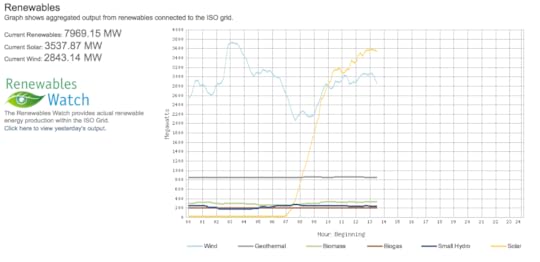 And it's only March! By June we may see sunny, windy days that reach 50% of demand.
And it's only March! By June we may see sunny, windy days that reach 50% of demand.
This by and large doesn't include renewable production "behind the meter" such as rooftop solar. It is likely rooftop solar produced another 3000 megawatts or so. (Rooftop solar generally shows up as reduced demand.)
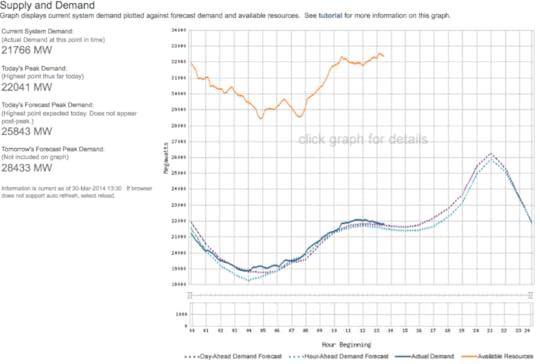
Now this was just for ten minutes. It is likely over the course of the day renewables will be equivalent to only 20% or so the day's electricity demand. (Edit: it turns out on March 30th renewables fed into California's utility grid were equivalent to 25% of the day's 24 hr electricity demand.) But to put this 8202 megwatts in perspective, 30 states in the US averaged less than 8000MW/hour of electricity consumption in 2013. Of course all those states have much lower populations than California. However, California had the lowest per capita electric consumption of the country last year, followed closely by Hawaii. (Climate has a lot to do with it.)
Both California and Hawaii significantly dropped their per capita electricity consumption from 2012 to 2013, California by 2% and Hawaii by nearly 2 1/2%, due to a combination of efficiency measures and increased rooftop solar.Very little wind power was added in California last year, but a heck of a lot of utility scale solar went on line in the 4th quarter of 2013, and we're seeing the results now.
If you're interested in tracking California's renewable electricity production, follow this link. Another fun link is Denmark's real-time electricity production graphic, complete with little turning windmills.
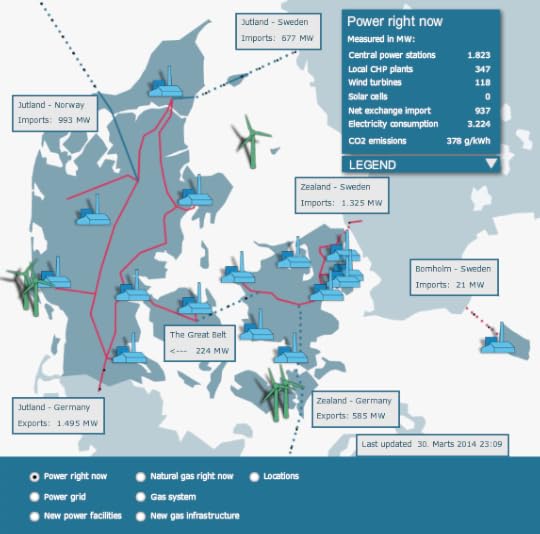 You can see how they import and export electricity from Norway, Sweden and Germany to balance out their own production when the wind isn't blowing or when it's blowing a lot.
You can see how they import and export electricity from Norway, Sweden and Germany to balance out their own production when the wind isn't blowing or when it's blowing a lot.
 And it's only March! By June we may see sunny, windy days that reach 50% of demand.
And it's only March! By June we may see sunny, windy days that reach 50% of demand.This by and large doesn't include renewable production "behind the meter" such as rooftop solar. It is likely rooftop solar produced another 3000 megawatts or so. (Rooftop solar generally shows up as reduced demand.)

Now this was just for ten minutes. It is likely over the course of the day renewables will be equivalent to only 20% or so the day's electricity demand. (Edit: it turns out on March 30th renewables fed into California's utility grid were equivalent to 25% of the day's 24 hr electricity demand.) But to put this 8202 megwatts in perspective, 30 states in the US averaged less than 8000MW/hour of electricity consumption in 2013. Of course all those states have much lower populations than California. However, California had the lowest per capita electric consumption of the country last year, followed closely by Hawaii. (Climate has a lot to do with it.)
Both California and Hawaii significantly dropped their per capita electricity consumption from 2012 to 2013, California by 2% and Hawaii by nearly 2 1/2%, due to a combination of efficiency measures and increased rooftop solar.Very little wind power was added in California last year, but a heck of a lot of utility scale solar went on line in the 4th quarter of 2013, and we're seeing the results now.
If you're interested in tracking California's renewable electricity production, follow this link. Another fun link is Denmark's real-time electricity production graphic, complete with little turning windmills.
 You can see how they import and export electricity from Norway, Sweden and Germany to balance out their own production when the wind isn't blowing or when it's blowing a lot.
You can see how they import and export electricity from Norway, Sweden and Germany to balance out their own production when the wind isn't blowing or when it's blowing a lot.
Published on March 30, 2014 14:19
March 17, 2014
Wrassling Angels: In Memoriam Jeff Shannon
 I attended Jeff Shannon’s memorial service yesterday on the site of my old high school. (I say ‘site’ because my high school was torn down fifteen years ago and rebuilt from scratch. Lesson in impermanence.) Jeff died of complications from pneumonia in December. Another lesson in impermanence. The location of the gathering was appropriate because Jeff also attended Meadowdale High School in Lynnwood, Washington oh so many years ago. We were in the graduating class of 1979, affectionately nicknamed the “Smelts.” Many of my fellow Smelts were there yesterday. I suppose we are all getting to a time of life when attending funerals and memorial services have begun to regularly punctuate our years.
I attended Jeff Shannon’s memorial service yesterday on the site of my old high school. (I say ‘site’ because my high school was torn down fifteen years ago and rebuilt from scratch. Lesson in impermanence.) Jeff died of complications from pneumonia in December. Another lesson in impermanence. The location of the gathering was appropriate because Jeff also attended Meadowdale High School in Lynnwood, Washington oh so many years ago. We were in the graduating class of 1979, affectionately nicknamed the “Smelts.” Many of my fellow Smelts were there yesterday. I suppose we are all getting to a time of life when attending funerals and memorial services have begun to regularly punctuate our years.Yesterday I heard stories about Jeff, many I hadn’t known, from friends, colleagues and family. It was good to have an overview of Jeff’s life and hear tribute from the many people who loved him. But even before his passing, Jeff has long been on my mind.
Two weeks after we graduated from high school (and stayed up all night in the senior grad party writing deep thoughts in each other’s yearbooks) and a few weeks shy of his eighteenth birthday, Jeff went to Hawaii and broke his neck in a diving accident. Spinal cord injury. He was on a trip with other kids from my high school. When the accident happened, these kids saved his life. Jeff spent the next thirty-four years living with the reality of C-5/6 quadriplegia. This, Wikipedia tells me, meant he had some function of biceps and shoulders but little or none of his wrists or hands. And no controllable function in the torso below the diaphragm.
I think I heard about Jeff’s accident a few weeks after it happened, during a rather horrible summer when I was working in a paint factory earning money for college. I was shocked but imagined Jeff would probably get better. Eighteen year olds are, after all, optimists, and I had my own worries and concerns and future ahead.
 I have a cousin who has been a paraplegic since the age of twelve, so I had some inkling what life in a wheelchair is like. Physically, at least. Mentally, spiritually, much less so. I didn’t understand why life had meted out this karate chop of fate to Jeff of all people. Even at eighteen it seemed frighteningly random. In the book of Genesis, one night Jacob is beside a stream and some guy comes out of nowhere, attacks him, and they wrestle all night, neither getting the upper hand. In the morning, it turns out the pugnacious thug was an angel. Why did the angel pick on Jacob? Why all night? Why did the angel wrestle and not, say, offer Jacob a nice back massage? Why?
I have a cousin who has been a paraplegic since the age of twelve, so I had some inkling what life in a wheelchair is like. Physically, at least. Mentally, spiritually, much less so. I didn’t understand why life had meted out this karate chop of fate to Jeff of all people. Even at eighteen it seemed frighteningly random. In the book of Genesis, one night Jacob is beside a stream and some guy comes out of nowhere, attacks him, and they wrestle all night, neither getting the upper hand. In the morning, it turns out the pugnacious thug was an angel. Why did the angel pick on Jacob? Why all night? Why did the angel wrestle and not, say, offer Jacob a nice back massage? Why?At Meadowdale (doesn’t it sound bucolic, like a land of frolicking sheep?) we all knew, and took for granted, that Jeff was immensely talented. So talented that he could shine effortlessly in multiple areas at once. He could sing. He could dance. He could act. As his brother said yesterday (or was it his sister?) when Jeff got up on a stage, your eye followed him. You couldn’t help it. He was charming. He was handsome. Things came easily for him. He had a future.
He was also quite a writer, even then. I remember during the infamous spring quarter of our last year of high school, when every senior had checked out mentally even if the body was still required to be present, and watching with awe as Jeff sat down an hour before a paper for college prep English was due. In the next forty-five minutes he proceeded to handwrite a five-paragraph essay with a thesis, development and conclusion. When it was done, he turned it in and received a pretty decent grade. It was a paper I’d spent at least six hours on (and typed!) so I was both indignant and envious it came so easily to him. It was clear that writing was already a strength of his, even if the greatest value of that strength was to allow him to spit out a paper pronto so he could dedicate time to other pursuits. (I’m pretty sure if he’d allowed himself a second draft, he could’ve outwritten us all back then.)
 So all this talent, all this energy, all this future. And then wham. The metaphoric angel of Genesis knocks him down with one of the biggest body blows life has to offer. Why did it have to be Jeff? It could have been anyone of us. Why did life make that absolutely extraordinary demand of him?
So all this talent, all this energy, all this future. And then wham. The metaphoric angel of Genesis knocks him down with one of the biggest body blows life has to offer. Why did it have to be Jeff? It could have been anyone of us. Why did life make that absolutely extraordinary demand of him?If Jeff’s life were a movie or a novel, the spinal cord injury would be the inciting event, the point where the character moves from routine/normal/status quo into heroic territory where great achievement and great failure become possible. To overcome the presented conflict/obstacle the character must struggle, adapt, change. He (or she) must draw on both internal and external resources, invariably discovering ones he didn’t know he had. In a comedy, the process of defeating the obstacle/resolving the conflict causes the character to grow/develop/experience epiphany and achieve a higher level of existence/consciousness. (In a tragedy the obstacle defeats the hero.)
At least that’s how it works in stories.
As far as I can tell, Jeff did proceed down the hero’s path. With the help of friends and family he faced what he had to, transcended much, and achieved a level of spiritual accomplishment that I haven’t often run across in the days of my life.
How do I know this? Over the last thirty-four years I’ve only seen Jeff in person a few times. But in the last five years, through the double-edged sword known as Facebook, I have read Jeff’s writings. I was especially enamored with his contributions to Facing Disability.com where he had his own column/blog. I encourage you to read his posts. They are still up. Especially, “Finding Plan B,” “Happiness is A Choice,” and “Mother Nature Wants to Kill You.”
It is in these writings that I see both evidence of his struggles and his achievements. I see that he wrestled his way through the five stages of grief and came out in a place not so many of us ever get to. He did it through day-in, day-out perseverance, guts and courage. (In the end, is there any other way?) Combine this with his enormous intelligence and creativity, and you get the kind of life and achievement he was able to create for himself.
 When I speak of achievement, I am not talking about money, or fame, or popularity, or awards. I am not even talking about love. (It’s clear Jeff's heart was open to give and receive love, and that this was an important source of his strength.) What I admire and respect Jeff intensely for was his willingness to undertake a terrifically difficult journey that asked so much of him. That he had a deep enough sense of himself and the universe to understand that the journey was worth the effort. That though he’d been put down on a path far outside his ken, that offered few of the conventional rewards any boy of his age might want, that meant constant physical and emotional struggle, he rose to the occasion and became a man in the process. He wrestled that angel, an angel that fought dirty and mean. And while I wouldn’t say he ever won, like Jacob in the Bible, Jeff did last out the night. He did find joy and meaning and grace and spirit. He did prevail and perhaps was blessed.
When I speak of achievement, I am not talking about money, or fame, or popularity, or awards. I am not even talking about love. (It’s clear Jeff's heart was open to give and receive love, and that this was an important source of his strength.) What I admire and respect Jeff intensely for was his willingness to undertake a terrifically difficult journey that asked so much of him. That he had a deep enough sense of himself and the universe to understand that the journey was worth the effort. That though he’d been put down on a path far outside his ken, that offered few of the conventional rewards any boy of his age might want, that meant constant physical and emotional struggle, he rose to the occasion and became a man in the process. He wrestled that angel, an angel that fought dirty and mean. And while I wouldn’t say he ever won, like Jacob in the Bible, Jeff did last out the night. He did find joy and meaning and grace and spirit. He did prevail and perhaps was blessed.I suppose we all wrestle with our night of angels in one way or another. Why Jeff got that particular one is still a mystery to me. But I do see that Jeff was on a hero’s journey that transformed him. I suspect he is still on that journey. I hope in some way, some form, our paths cross again. However, you don't get to choose your angel. It chooses you.
Published on March 17, 2014 18:34
January 24, 2014
Natural Gas Prices Are Soaring. Here's What You Can Do.
 Up, up, upThough it’s not getting much attention yet, natural gas prices are zooming upwards due to the cold winter the US has been experiencing. (Propane prices have been increasing as well.) If you use natural gas for space heating or hot water, these higher prices will necessarily be reflected in your upcoming utility bills. Though these higher prices are no doubt temporary, fundamentally the cost structure of fracking and drilling for natural gas is such that energy companies are losing money on natural gas plays at current prices and so have dropped drilling dramatically. Though current production is coasting along, some analysts say natural gas won’t be profitable for any new plays until it reaches $6/mmbtu. In November the price of natural gas was at $3.60/mmbtu. Today it is at $5.22/mmbtu.
Up, up, upThough it’s not getting much attention yet, natural gas prices are zooming upwards due to the cold winter the US has been experiencing. (Propane prices have been increasing as well.) If you use natural gas for space heating or hot water, these higher prices will necessarily be reflected in your upcoming utility bills. Though these higher prices are no doubt temporary, fundamentally the cost structure of fracking and drilling for natural gas is such that energy companies are losing money on natural gas plays at current prices and so have dropped drilling dramatically. Though current production is coasting along, some analysts say natural gas won’t be profitable for any new plays until it reaches $6/mmbtu. In November the price of natural gas was at $3.60/mmbtu. Today it is at $5.22/mmbtu.What can be done to avoid inflated utility bills?
Short term, these might work:1) Install a programmable thermostat and actually program it. (It is estimated 40% of people who have programmable thermostats don’t program them.) The benefit to this is that you don’t have to constantly remember to turn the thermostat down at night or when you leave. It does it for you. Add a blanket to your bed and set nighttime temperatures to 60 -62. Drop temperatures while you’re away from home to 55 degrees. Yes, this does save significant energy even though your heater will be blasting for a short while to get temperatures back up when you return or wake up.2) Put on a sweater and reduce your household normal temperature two degrees. If your kids are comfortable walking around barefoot in the winter, your house is too warm! (Hello, I tell my kids, you don’t live in Tahiti!)3) Don’t light a fire in the fireplace. This may be counterintuitive, but when you light a fire, your natural gas-warmed air flies up your chimney, sucking out far more heat from your house than the fire contributes. However, if you have a fireplace insert or wood stove (even better a high-efficiency one), then burning wood will reduce your use of natural gas rather than increase it.4) Install a low-flow showerhead. There are good ones out there that use only 1.5 gallons of hot water a minute. This reduces the load on your hot water heater significantly. Wash clothes in warm or cold, not hot water. Let family members know that pajamas and towels should be used/worn more than once before washing.5) If your hot water heater is not insulated, read no further. Go insulate it right now. I mean it. Every home improvement-type store sells hot water heater insulating wraps/blankets.6) Feel around your doors and windows for drafts. Get ten dollars of weather stripping material and do what you can to reduce these drafts.7) Close off rooms not in use and close off vents to these rooms.8) Wear wool. I do this. A lot. The interior temperature of my house is 60 degrees as I write this.9) Get some exercise. Raising your metabolism through exercise will make a slightly cooler house still comfortable to you.10) Consider drying your clothes outside on the line on sunny days.11) Open your curtains for solar gain during the day; close them for their thermal properties at night. 12) Cooking doesn’t use much natural gas, at least not compared to space heating. In general I wouldn’t worry about cooking, however I do use an electric kettle to boil water and an electric crockpot for making broth.
 Medium term
Medium term1) Insulate, insulate, insulate. Best investment you can make. Heat wants to rise, so work on the attic first. Seal off the attic from air movement (insulation prevents heat from traveling, not air, so if air can travel, you’ll get heat losses from that), then make sure insulation is at least knee-deep.2) If your house is drafty, get a professional to do a thorough weather stripping. (Note: if your house is drafty, 70 degrees can feel like 66. And if your house is not drafty, 66 can feel like 70.)3) If you live some place crazy like California, your walls may have no insulation in them. I’m serious. Ours didn’t. Blowing in insulation can fix this.4) Time to think about the underpart of your house—the crawl space or basement. If there is no insulation between your warm, comfy house and the cold air beneath it, there will be an energy transfer, which means you’ll lose heat. It may seem silly to insulate the floor from underneath (and in many homes it is often not possible) but if you can, it does work.5) Seal your heating ducts or have someone do it for you. Poorly sealed ducts can reduce the efficiency of your heating system by 30%.6) Make sure the filter on your heater is not clogged and reducing your heating efficiency.7) If for any reason you need to replace your hot water heater, consider a heat pump version, or a solar-powered (with a heat pump back up) version. If you have a secondary hot water heater that is little used, consider putting in an on-demand system instead. Yes, up front costs for these new, more efficient technologies are higher, but some tax credits are still available and you might have local incentives from your utility as well. You’ll get the money back in lower energy costs within seven years even with natural gas at $4/mmbtus. (Faster with higher nat gas prices.)8) Double and even triple-paned windows. Windows are expensive, and the walls, attic and the underpart of your house are cheaper and probably more important to address. But if your windows are single-paned and drafty, at some point they will need to be tackled. I am really happy with the fiberglass-framed windows we’ve put in our house. They look very much like wood-framed ones, they don’t need paint, they seal tightly (locking out both noise and air transfer), and fiberglass expands and contracts at the same ratio that glass does, so it is not prone to warping like wood. In general they are more expensive than aluminum/vinyl but less expensive than wood.9) If you’ve got your house reasonably tight and live where it’s really cold, consider a heat-exchange ventilation system that reduces energy losses by transferring heat between outgoing and incoming air.10) Consider replacing any large evergreens on the south side of your house with deciduous trees so you will get a solar gain in the winter but still get shade in the summer.11) Do not rely on electric baseboard heaters or space heaters. They are wildly inefficient in terms of energy use, and as natural gas prices go up, so inevitably will electricity costs. A heat pump will cost you far, far less to heat your house.12) If you replace your dishwasher/washing machine, get the lowest water use, highest efficiency-rated ones you can find.
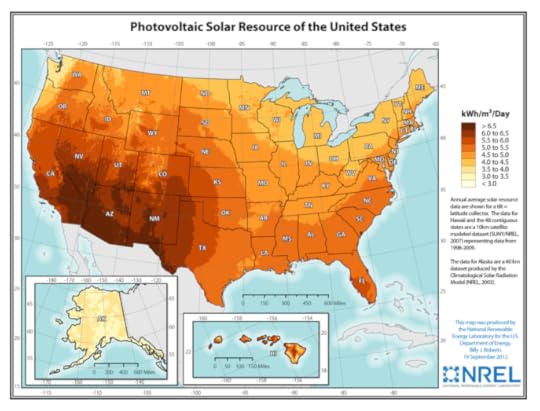 The US is lucky it is so well-suited to solar.Long term1) Let’s face it, long term almost all of us will be heating our houses (that have become very well insulated) via electricity with heat pumps. And those of us who live in regions that have above 4 kilowatt-hours per square meter per day solar potential (i.e. most of the continental US and Hawaii—check out the map) are going to end up with solar panels on our roofs. It’s a matter of when, not if. Heat pumps are now available that work in outdoor temperatures below zero degrees, and the technology will continue to improve. Big plus—if you live where it’s hot in the summer, heat pumps also cool! And they are more energy efficient at this than current air conditioners. 2) If you ever have the opportunity/need to build a new house, be smart and make it zero net energy. Whereas it’s somewhat difficult to retrofit an existing house to be tight enough to be highly energy-efficient, it’s not hard at all when building one from scratch. Use passive solar where appropriate, insulate massively, make it air tight with a heat exchange ventilator, stick some solar panels on the roof, and put in a heat pump for the small amount of heating and cooling you still might need. It will only cost $10-$20K extra, and you’ll have almost no future utility bills. You will be all set for the rest of the 21st century!
The US is lucky it is so well-suited to solar.Long term1) Let’s face it, long term almost all of us will be heating our houses (that have become very well insulated) via electricity with heat pumps. And those of us who live in regions that have above 4 kilowatt-hours per square meter per day solar potential (i.e. most of the continental US and Hawaii—check out the map) are going to end up with solar panels on our roofs. It’s a matter of when, not if. Heat pumps are now available that work in outdoor temperatures below zero degrees, and the technology will continue to improve. Big plus—if you live where it’s hot in the summer, heat pumps also cool! And they are more energy efficient at this than current air conditioners. 2) If you ever have the opportunity/need to build a new house, be smart and make it zero net energy. Whereas it’s somewhat difficult to retrofit an existing house to be tight enough to be highly energy-efficient, it’s not hard at all when building one from scratch. Use passive solar where appropriate, insulate massively, make it air tight with a heat exchange ventilator, stick some solar panels on the roof, and put in a heat pump for the small amount of heating and cooling you still might need. It will only cost $10-$20K extra, and you’ll have almost no future utility bills. You will be all set for the rest of the 21st century!Any other ideas to keep natural gas bills low? List them in the comments!
Published on January 24, 2014 13:49



